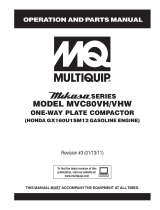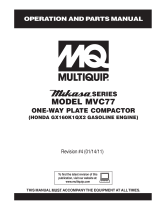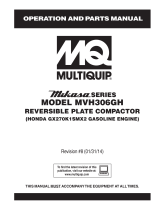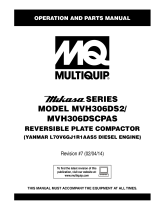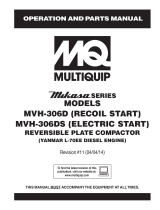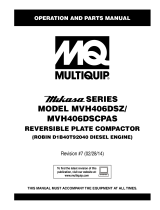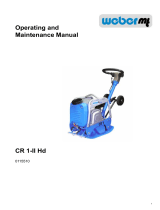Page is loading ...

OPERATION MANUAL
THIS MANUAL MUST ACCOMPANY THE EQUIPMENT AT ALL TIMES.
SERIES
MODEL MVC82VGV/VGVW
ONE-WAY PLATE COMPACTOR
(Briggs & Stratton Vanguard 160 Gasoline Engine)
Revision #0 (04/24/2023)
To nd the latest revision of this publication or
associated parts manual, visit our website at:
www.multiquip.com

PAGE 2 — MVC82VGV/VGVW PLATE COMPACTOR • OPERATION MANUAL — REV. #0 (04/24/23)
PROPOSITION 65 WARNING

MVC82VGV/VGVW PLATE COMPACTOR • OPERATION MANUAL — REV. #0 (04/24/23) — PAGE 3
NOTES

PAGE 4 — MVC82VGV/VGVW PLATE COMPACTOR • OPERATION MANUAL — REV. #0 (04/24/23)
TABLE OF CONTENTS
MVC82VGV/VGVW
Plate Compactor
Proposition 65 Warning ........................................... 2
Safety Information ................................................ 5-9
Specications ........................................................ 10
Noise And Vibration Emissions ...............................11
Dimensions ............................................................ 12
General Information ............................................... 13
Components .......................................................... 14
Basic Engine .......................................................... 15
Inspection ......................................................... 16-17
Operation .......................................................... 18-19
Maintenance ..................................................... 20-23
Storage .................................................................. 23
Troubleshooting (Engine) ................................. 24-25
Troubleshooting (Compactor) ................................ 26
NOTICE
Specications and part numbers are subject to change
without notice.

MVC82VGV/VGVW PLATE COMPACTOR • OPERATION MANUAL — REV. #0 (04/24/23) — PAGE 5
SAFETY INFORMATION
Do not operate or service the equipment before reading
the entire manual. Safety precautions should be followed
at all times when operating this equipment.
Failure to read and understand the safety
messages and operating instructions could
result in injury to yourself and others.
SAFETY MESSAGES
The four safety messages shown below will inform you
about potential hazards that could injure you or others. The
safety messages speci cally address the level of exposure
to the operator and are preceded by one of four words:
DANGER, WARNING, CAUTION
or NOTICE.
SAFETY SYMBOLS
DANGER
Indicates a hazardous situation which, if not avoided,
WILL result in DEATH or SERIOUS INJURY.
WARNING
Indicates a hazardous situation which, if not avoided,
COULD result in DEATH or SERIOUS INJURY.
CAUTION
Indicates a hazardous situation which, if not avoided,
COULD result in MINOR or MODERATE INJURY.
NOTICE
Addresses practices not related to personal injury.
Potential hazards associated with the operation of this
equipment will be referenced with hazard symbols which
may appear throughout this manual in conjunction with
safety messages.

PAGE 6 — MVC82VGV/VGVW PLATE COMPACTOR • OPERATION MANUAL — REV. #0 (04/24/23)
SAFETY INFORMATION
GENERAL SAFETY
CAUTION
NEVER operate this equipment without proper protective
clothing, shatterproof glasses, respiratory protection,
hearing protection, steel-toed boots and other protective
devices required by the job or city and state regulations.
NEVER operate this equipment when not
feeling well due to fatigue, illness or when
under medication.
NEVER operate this equipment under the in uence of
drugs or alcohol.
ALWAYS check the equipment for loosened threads or
bolts before starting.
DO NOT use the equipment for any purpose other than
its intended purposes or applications.
ALWAYS clear the work area of any debris, tools, etc.
that would constitute a hazard while the equipment is
in operation.
NOTICE
This equipment should only be operated by trained and
quali ed personnel 18 years of age and older.
Whenever necessary, replace nameplate, operation and
safety decals when they become dif cult read.
Manufacturer does not assume responsibility for any
accident due to equipment modi cations. Unauthorized
equipment modi cation will void all warranties.
NEVER
use accessories or attachments that are not
recommended by Multiquip for this equipment. Damage
to the equipment and/or injury to user may result.
ALWAYS know the location of the nearest
re extinguisher.
ALWAYS know the location of the nearest
rst aid kit.
ALWAYS know the location of the nearest phone or
keep
a phone on the job site.
Also, know the phone numbers
of the nearest ambulance, doctor and
re department.
This information will be invaluable in the case of an
emergency.

MVC82VGV/VGVW PLATE COMPACTOR • OPERATION MANUAL — REV. #0 (04/24/23) — PAGE 7
SAFETY INFORMATION
COMPACTOR SAFETY
DANGER
NEVER operate the equipment in an explosive
atmosphere or near combustible materials. An
explosion or re could result causing severe
bodily harm or even death.
WARNING
NEVER disconnect any emergency or safety devices.
These devices are intended for operator safety.
Disconnection of these devices can cause severe injury,
bodily harm or even death. Disconnection of any of these
devices will void all warranties.
CAUTION
NEVER lubricate components or attempt service on a
running machine.
NOTICE
ALWAYS keep the machine in proper running condition.
Fix damage to machine and replace any broken parts
immediately.
ALWAYS store equipment properly when it is not being
used. Equipment should be stored in a clean, dry location
out of the reach of children and unauthorized personnel.
ENGINE SAFETY
DANGER
The engine fuel exhaust gases contain poisonous carbon
monoxide. This gas is colorless and odorless, and can
cause death if inhaled.
The engine of this equipment requires an adequate
free ow of cooling air. NEVER operate this equipment
in any enclosed or narrow
area where free ow of the
air is restricted. If the air
ow is restricted it will cause
injury to people and property
and serious damage to the
equipment or engine.
WARNING
DO NOT
place hands or fingers inside engine
compartment when engine is running.
NEVER
operate the engine with heat shields or
guards removed.
Keep ngers, hands hair and clothing away
from all moving parts to prevent injury.
DO NOT remove the radiator cap while the
engine is hot. High pressure boiling water will gush out
of the radiator and severely scald any persons in the
general area of the compactor.
DO NOT remove the coolant drain plug
while the engine is hot. Hot coolant will
gush out of the coolant tank and severely
scald any persons in the general area of
the compactor.
DO NOT
remove the engine oil drain plug while the
engine is hot. Hot oil will gush out of the oil tank and
severely scald any persons in the general area of the
compactor.
CAUTION
NEVER touch the hot exhaust manifold,
muf er or cylinder. Allow these parts to cool
before servicing equipment.
NOTICE
NEVER
run engine without an air lter or with a dirty air
lter. Severe engine damage may occur. Service air lter
frequently to prevent engine malfunction.
NEVER tamper with the factory settings of
the engine or engine governor. Damage
to the engine or equipment can result
if operating in speed ranges above the
maximum allowable.
NEVER
tip the engine to extreme angles during lifting as
it may cause oil to gravitate into the cylinder head, making
the engine start dif cult.

PAGE 8 — MVC82VGV/VGVW PLATE COMPACTOR • OPERATION MANUAL — REV. #0 (04/24/23)
SAFETY INFORMATION
FUEL SAFETY
DANGER
DO NOT add fuel to equipment if it is placed inside truck
bed with plastic liner. Possibility exists of explosion or
re due to static electricity.
DO NOT start the engine near spilled fuel or combustible
uids. Diesel fuel is extremely ammable and its vapors
can cause an explosion if ignited.
ALWAYS refuel in a well-ventilated area, away from
sparks and open ames.
ALWAYS use extreme caution when working with
fl ammable liquids.
DO NOT ll the fuel tank while the engine is running
or hot.
DO NOT over ll tank, since spilled fuel could ignite if it
comes into contact with hot engine parts or sparks from
the ignition system.
Store fuel in appropriate containers, in well-ventilated
areas and away from sparks and ames.
NEVER use fuel as a cleaning agent.
DO NOT smoke around or near the
equipment. Fire or explosion could result
from fuel vapors or if fuel is spilled on a
hot engine.
FUEL
FUEL
BATTERY SAFETY (ELECTRIC START ONLY)
DANGER
DO NOT
drop the battery. There is a possibility that the
battery will explode.
DO NOT expose the battery to open ames,
sparks, cigarettes, etc. The battery contains
combustible gases and liquids. If these
gases and liquids come into contact with a
ame or spark, an explosion could occur.
WARNING
ALWAYS wear safety glasses when
handling the battery to avoid eye irritation.
The battery contains acids that can cause
injury to the eyes and skin.
Use well-insulated gloves when picking up
the battery.
ALWAYS
keep the battery charged. If the battery is not
charged, combustible gas will build up.
DO NOT
charge battery if frozen. Battery can explode.
When frozen, warm the battery to at least 61°F (16°C).
ALWAYS
recharge the battery in a well-ventilated
environment to avoid the risk of a dangerous concentration
of combustible gases.
If the battery liquid (dilute sulfuric acid)
comes into contact with clothing or skin,
rinse skin or clothing immediately with
plenty of water.
If the battery liquid (dilute sulfuric acid) comes into
contact with eyes
, rinse eyes immediately with plenty
of water and contact the nearest doctor or hospital to
seek medical attention.
CAUTION
ALWAYS disconnect the
NEGATIVE battery terminal
before performing service on the equipment.
ALWAYS
keep battery cables in good working condition.
Repair or replace all worn cables.

MVC82VGV/VGVW PLATE COMPACTOR • OPERATION MANUAL — REV. #0 (04/24/23) — PAGE 9
TRANSPORTING SAFETY
CAUTION
NEVER allow any person or animal to stand underneath
the equipment while lifting.
NOTICE
Before lifting, make sure that the equipment parts (hook
and vibration insulator) are not damaged and screws are
not loose or missing.
Always make sure crane or li tng device has been
properly secured to the lifting bail (hook) of the
equipment.
ALWAYS shutdown engine before transporting.
NEVER lift the equipment while the engine is running.
Tighten fuel tank cap securely and close fuel cock to
prevent fuel from spilling.
Use adequate lifting cable (wire or rope) of suf cient
strength.
Use one point suspension hook and lift straight upwards.
DO NOT lift machine to unnecessary heights.
ALWAYS tie down equipment during transport by
securing the equipment with rope.
ENVIRONMENTAL SAFETY
NOTICE
Dispose of hazardous waste properly.
Examples of potentially hazardous waste
are used motor oil, fuel and fuel lters.
DO NOT use food or plastic containers to dispose of
hazardous waste.
DO NOT pour waste, oil or fuel directly onto the ground,
down a drain or into any water source.
SAFETY INFORMATION

PAGE 10 — MVC82VGV/VGVW PLATE COMPACTOR • OPERATION MANUAL — REV. #0 (04/24/23)
SPECIFICATIONS
Table 1. Compactor Specications
Models MVC82VGV
MVC82VGVW
Handle Vibration Absorbing System (VAS) Center
Handle
Centrifugal Force 3080 lbf. (13.7 kN, 1400 kg)
Vibrating Frequency 5,600 vibrations/min (93 Hz)
Maximum Traveling Speed 82 ft./min (25 m/min)
Plate Size (LxW) 22.4 x 17.7 in. (570 x 450 mm)
Length (Including Handle) 22.4 in. (570 mm)
Height (Including Handle) 38.2 inch (970 mm)
Operating Weight* (VGV)
Operating Weight* (VGVW)
185 lbs. (84 kg)
202 lbs. (92 kg)
Water Tank Capacity (VGVW Model Only) 11.6 qt. (11.0 liters)
Max. Area Of Compaction 7266 sq. ft./hour (675 sq. m/hour)
Vibrator Oil Capacity 0.15 qt. (0.14 liters)
* - Weight includes weight of machine, lubricants, 50% of fuel tank and 50% of water if with water tank.
Table 2. Engine Specications
Make Briggs & Stratton
Model VANGUARD 160, 10V332 0051 F1
Type Air-cooled, 4-stroke Gasoline Engine
Max Output 5 HP.(3.7 kW/3600 R.P.M.
Fuel Tank Capacity Approx. 0.82 gal. (3.10 liters)
Fuel Unleaded Automobile Gasoline
Engine Oil Grade API SF or higher SAE5W-30 Synthetic Oil
Engine Oil Capacity 0.63 qt. (0.59 liters)
PTO Shaft Metric
Starting Method Recoil Start

MVC82VGV/VGVW PLATE COMPACTOR • OPERATION MANUAL — REV. #0 (04/24/23) — PAGE 11
NOTES:
1. Products are tested for sound pressure level in accordance with European Directives and Standards 2000/14/EC, 2006/42/EC, 2014/30/EU,
EN 500-1:2006 +A1:2009 , EN 500-4:2011, relating to Noise Emission in the Environment by equipment for use outdoors.
2. Products are tested for hand/arm vibration (HAV) level in accordance with European Directives 2002/44/EC and EN500-4 and ISO 5349-1:2001,
ISO 5349-2:2001.
Table 3. Noise and Vibration Emissions
Measured Sound Power Level in dB(A) 103
Guaranteed Sound Power Level in dB(A) 105
Hand-Arm Vibration in m/s23.8
NOISE AND VIBRATION EMISSIONS

PAGE 12 — MVC82VGV/VGVW PLATE COMPACTOR • OPERATION MANUAL — REV. #0 (04/24/23)
DIMENSIONS
A
B
C
D E
Table 4. Dimensions
Reference Letter Description Dimension
A Length (including handle) 38.2 inches (970 mm)
B Height (without handle) 22.4 inches (570 mm)
C Height (including handle) 38.2 inches (970 mm)
D Plate Length 22.4 inches (570 mm)
E Plate Width 17.7 inches (450 mm)

MVC82VGV/VGVW PLATE COMPACTOR • OPERATION MANUAL — REV. #0 (04/24/23) — PAGE 13
GENERAL INFORMATION
DEFINITION OF PLATE COMPACTOR
The Mikasa MVC82VGV/VGVW is a walk-behind, one-way
plate compactor designed for the compaction of sand,
mixed soils and asphalt. This plate compactor is a powerful
compacting tool capable of applying a tremendous force in
consecutive high frequency vibrations to a soil surface. Its
applications include compacting for road, embankments
and reservoirs as well as backlling for gas pipelines, water
pipelines and cable installation work.
VIBRATORY PLATES
The vibratory plates of the MVC82VGV/VGVW produce low
amplitude high frequency vibrations, designed to compact
granular soils and asphalt.
The resulting vibrations cause forward motion. The engine
and handle are vibration-isolated from the vibrating plate.
FREQUENCY/SPEED
The compactor's vibrating plate has a frequency range of
5600 vpm (vibrations per minute). The travel speed of the
compactor is approximately 82 feet/minute (25 meters/
minute).
ENGINE
These plate compactors are equipped with a Briggs &
Stratton Vanguard 160, air cooled, 4-cycle gasoline engine.
Reference Table 2 for complete specications. The engine
drives an eccentric weight at a high speed to develop a
compaction force.
CONTROLS
Before starting the plate compactor, identify and understand
the function of all the controls and components.

PAGE 14 — MVC82VGV/VGVW PLATE COMPACTOR • OPERATION MANUAL — REV. #0 (04/24/23)
COMPONENTS
Figure 1. Plate Compactor Components
11
9
10
5
6
7
8
4
2
3
1
Figure 1 shows the location of the basic controls and
components of the MVC82VGV/VGVW Plate Compactor.
The function of each control is described below:
1. Handle Bar — When operating the compactor, se this
handle bar to maneuver the compactor.
2. Vibrator Oil Drain Plug — Used to drain vibrator oil
from the machine.
3. Shock Absorber — Absorbs or damps shock impulses.
4. Lifting Grip — Used to lift the plate compactor.
5. Belt Cover — Remove this cover to gain access to the
V-belts. NEVER run the compactor without the V-belt
cover. If the V-belt cover is not installed, the possibility
exists that your hand may get caught between the
V-belt and clutch, causing serious injury and bodily
harm.
6. Vibrating Plate — A at, open plate made of durable
cast iron construction used in the compacting of soil.
7. Vibration Case — Encloses the eccentric, gears and
counter weights.
8. Lifting Bale — When lifting of the compactor is
required either by forklift, crane, etc., tie rope or chain
around this lifting point.
9. Water Tank Cap (VGVW Only) — Remove this cap
to add water to the water tank.
10. Water Tank (VGVW only) — Holds 11.6 quarts of
water (removable, no tools required).
11. Water Shut-Off Valve (VGVW only) — Turn this valve
downward to let water ow from the water tank to the
water tube.

MVC82VGV/VGVW PLATE COMPACTOR • OPERATION MANUAL — REV. #0 (04/24/23) — PAGE 15
BASIC ENGINE
Figure 2. Engine Components
2
13
4
5
6
7
8
9
10
7
6
11
The engine (Figure 2) must be checked for proper
lubrication and lled with fuel prior to operation. Refer to the
manufacturer's engine manual for instructions and details
of operation and servicing.
1. Air Cleaner — Prevents dirt and other debris from
entering the fuel system. Remove wing-nut on top of air
lter cover to gain access to lter element. Reference
the maintenance section in this manual for servicing.
2. Muffler — Used to reduce noise and emissions.
NEVER touch when hot!
3. Fuel Cap — Remove this cap to add unleaded gasoline
to the fuel tank. Fill with unleaded gasoline.
4. Fuel Tank — Refer to Table 5 for fuel tank capacity.
Make sure cap is tightened securely. DO NOT over
ll. For additional information refer to engine owner's
manual.
5. Dipstick/Oil Filler Cap — Remove this cap to
determine if the engine oil is low. Add oil through this
ller port as recommended in Table 5.
6. Oil Fill Plug — Remove this plug to add oil to the
engine crankcase.
7. Oil Drain Plug — Remove this plug to remove oil from
the engine crankcase.
8. Recoil Starter (Pull Rope) — Manual-starting method.
Pull the starter grip until resistance is felt, then pull
briskly and smoothly.
9. 3-in-1 Control Lever — Used as engine switch, fuel
valve lever, and throttle lever.
10. Choke Lever — Used in the starting of a cold engine,
or in cold weather conditions. The choke enriches the
fuel mixture.
11. Spark Plug — Provides spark to the ignition system.
Set spark plug gap according to engine manufacturer's
instructions. Clean spark plug once a week.
DANGER
Add fuel to the tank only when the engine
is stopped and has had an opportunity to
cool down. In the event of a fuel spill, DO
NOT attempt to start the engine until the
fuel residue has been completely wiped up
and the area surrounding the engine is dry.

PAGE 16 — MVC82VGV/VGVW PLATE COMPACTOR • OPERATION MANUAL — REV. #0 (04/24/23)
INSPECTION
BEFORE STARTING
1. Read all safety instructions at the beginning of manual.
2. Clean the compactor, removing dirt and dust,
particularly the engine cooling air inlet, carburetor and
air cleaner.
3. Check the air lter for dirt and dust. If air lter is dirty,
replace air lter with a new one as required.
4. Check carburetor for external dirt and dust. Clean with
dry compressed air.
5. Check fastening nuts and bolts for tightness.
ENGINE OIL CHECK
6. To check the engine oil level, place the compactor on
secure level ground with the engine stopped.
7. Remove the dipstick from the holder (Figure 3) and
wipe clean.
Figure 3. Engine Oil Dipstick Removal
8. Remove plug from oil ller. Insert dipstick into the oil
ller then remove. Check the oil level shown on the
dipstick.
9. If the oil level is low (Figure 3), ll to the edge of the
oil ller hole with the recommended oil type as listed
in Table 5. Refer to Table 2 for maximum engine oil
capacity.
UPPER LIMIT
LOWER LIMIT
Table 5. Oil Type
Season Temperature Oil Type
Summer 25°C or Higher SAE 10W-30
Spring/Fall 25°C~10°C SAE 10W-30/20
Winter 0°C or Lower SAE 10W-10
FUEL CHECK
1. Visually inspect (Figure 4) to see if fuel level is low. If
fuel is low, replenish with unleaded fuel.
Figure 4. Fuel Check
2. When refueling, be sure to use a strainer for ltration.
DO NOT top-off fuel. Wipe up any spilled fuel
immediately.
Water Tank (VGVW only)
If your unit is equipped with a water tank (Figure 5) and
your application requires water, ll water tank.
Figure 5. Water Tank Filling
WARNING
Adding fuel to the tank should be
accomplished only when the engine is
stopped and has had an opportunity to
cool down. In the event of a fuel spill, DO
NOT attempt to start the engine until the
fuel residue has been completely wiped up, and the
area surrounding the engine is dry.
REMOVE CAP AND
VISUALLY CHECK
FUEL LEVEL
WATER
TANK
WATER
SOURCE

MVC82VGV/VGVW PLATE COMPACTOR • OPERATION MANUAL — REV. #0 (04/24/23) — PAGE 17
INSPECTION
V-BELT CHECK
Figure 6. V-Belt Hazard
V-BELT INSPECTION
Visually examine the V-belt (Figure 7) and determine if it
is full of tiny cracks, frayed, has pieces of rubber missing,
is peeling or otherwise damaged.
Also, examine the belt and determine if it is oil soaked or
"glazed " (hard shiny appearance on the sides of the belt).
Either of these two conditions can cause the belt to run hot,
which can weaken it and increase the danger of it breaking.
If the V-belt exhibits any of the referenced wear conditions
replace the V-belt immediately.
Figure 7. Drive Belt Inspection
CAUTION
NEVER attempt to check the V-belt with the engine
running. Severe injury can occur if your hand (Figure 6)
gets caught between the V-belt and the clutch. Always
use safety gloves.
CLUTCH
PULLEY
VIBRATOR
PULLEY
GLAZED
OIL SOAKED
BROKEN
CORD FAILURE
CRACKS
MISSING RUBBER
SIDEWALL
WEAR
WORN BACK
COVER
V-BELT TENSION
1. If the V-belt tension is not proper, adjust the V-belt
tension. Slacken the four bolts xed the engine and turn
the nut for the V-belt tension adjuster until the V-belt
tension is correct. Retighten the bolts and recheck the
tension and alignment. (Figure 8.
Figure 8. V-Belt Tension
2. A loose V-belt will decrease the power transmission
output causing reduced compaction and premature
wear of the belt.
3. If the V-belt becomes worn or loose, replace it.
VIBRATOR OIL CHECK
1. Place the plate compactor horizontally on a at surface.
Make sure the compactor is level when checking the
oil in the vibrator assembly.
2. Check vibrator oil level by removing the oil plug
(vibrator oil gauge) as shown in Figure 9. The oil level
should be up to the oil drain plug. The vibrator holds
140 cc (approximately 0.3 pint). IMPORTANT, if oil is
required, replace using only SAE10W-30 motor oil.
Figure 9. Vibrator Oil Plug
V-BELT
TENSION
ADJUSTER
BOLT
BOLT
OIL DRAIN
PLUG
VIBRATOR

PAGE 18 — MVC82VGV/VGVW PLATE COMPACTOR • OPERATION MANUAL — REV. #0 (04/24/23)
OPERATION
INITIAL START-UP
1. Move the 3-in-1 control lever to the "ON" position. The
"ON" position means:
Engine Switch is ON
Fuel Valve is ON
Engine Speed is Idle
Figure 10. Engine 3-in-1Control Lever (ON)
2. Move the choke lever (Figure 10) to the “CLOSED”
position if starting a cold engine. To restart a warm
engine, leave the choke lever in the "OPEN".
3. Grasp the starter grip until you feel some resistance.
Then pull it briskly in the direction shown by the arrow
in Figure 11.
Figure 11. Starter Grip
Closed Open
CHOKE LEVER
3-in-1 CONTROL LEVER
Operation STOPON
4. When engine starts, release the starter grip and allow
the rope to recoil.
5. If the choke lever was moved to the "CLOSED" position
to start the engine, gradually move it to the "OPEN"
position (Figure 10) as the engine warms up.
6. Before the compactor is placed in to operation, run the
engine for several minutes. Check for fuel leaks, and
noises that would associate with a loose component.
7. After the engine has started, warm up the engine at idle
speed for 2 to 3 minutes. This is especially important
in cold weather.
OPERATION
8. Once the engine has started, move the 3-1 control
lever to the "Operation" position. The machine starts
vibrating.
Engine Switch is ON
Fuel Valve is ON
Engine Speed: Operation Speed
9. Firmly grasp the compactor's handle bar with both
hands. The compactor will begin moving forward.
10. Slowly walk behind the compactor and be on the
lookout for any large objects or foreign matter that
might cause damage to the compactor or bodily injury.
NOTICE
DO NOT pull the starter rope all the way to the end.
DO NOT release the starter rope after pulling. Allow it
to rewind as soon as possible.
CAUTION
Make sure to follow all safety rules referenced in
the safety information section of this manual before
operating compactor. Keep work area clear of debris
and other objects that could cause damage to the
compactor or bodily injury.
NOTICE
ALWAYS move the 3-in-1 control lever quickly without
hesitation, because increasing the engine speed slowly
causes the clutch to slip.

MVC82VGV/VGVW PLATE COMPACTOR • OPERATION MANUAL — REV. #0 (04/24/23) — PAGE 19
OPERATION
11. Compactor traveling speed may drop on soils which
contain clay. However, there may be cases where
traveling speed drops because the compaction plate
does not leave the ground surface easily due to the
composition of the soil. To rectify this problem, do the
following:
a. Check the bottom plate to see if clay or equivalent
material has been lodged in the plate mechanism.
If so, wash with water and remove.
b. Remember the compactor does not work as
efciently on clay or soils that have a high moisture
content level. If the soil has a high moisture level,
dry soil to appropriate moisture content level or
carry out compaction twice.
STOPPING THE ENGINE
Normal Shutdown
1. Move the 3-in-1 control lever to the “ON” position.
Cool down the engine for 3 to 5 minutes at idle speed
before stopping.
2. Move the 3-in-1 control lever to the “STOP” position.
The "STOP" position means:
Engine Switch is OFF
Fuel Valve is OFF
Engine Speed: STOP
CAUTION
NEVER stop the engine suddenly while working at
high speeds.

PAGE 20 — MVC82VGV/VGVW PLATE COMPACTOR • OPERATION MANUAL — REV. #0 (04/24/23)
MAINTENANCE
MACHINE INSPECTION
Perform machine inspection as listed in Table 6.
NOTICE
Inspection and other services should always be carried
out on hard and level ground with the engine shutdown.
Table 6. Machine Inspection
Interval Check Solution
Daily Before Starting
Machine Clean if necessary.
Fuel Tank For Leaks Repair fuel leaks.
Fuel System for Leaks Repair fuel leaks.
Engine Oil Add oil if necessary.
Vibrator Oil Add oil if necessary.
Air Cleaner Element Clean/Replace
Guard Frame Inspect/deformations
Shock Absorber Replace if damaged.
Hydraulic pump Check/Repair Leaks
Hydraulic Pipe System Check/Repair leaks,
Inspect for wear
Direction Control Lever Check bolts/nuts,
Inspect for wear
Duct Hose Check for crack/
damage
Every 20 Hours Engine Oil/Oil Filter Replace only after
rst 20 hrs.
Every 100 Hours
Engine Oil Change
Engine Oil Filter Wash
Vibrator Oil Check oil level.
Check for leaks/dirt.
Hydraulic Oil Check oil level.
Check for leaks.
Every 200 hours
V-Belt Inspect, replace if
damaged or worn.
Clutch Inspect, replace if not
working properly.
Engine Bolts
Replace bolts
if deformed or
elongated.
Every 300 hours
Vibrator Oil Change
Fuel Filter Change
Hydraulic Oil Change
Engine Oil Filter Change
Every 2 years Fuel Lines Replace
TIGHTENING TORQUE
Reference Table 7 below (Tightening Torque), for
retightening of nuts and bolts.
ENGINE OIL
1. Replace the engine oil in rst 20 hours of operation
and every 100 hours afterwards.
2. Replace engine oil with recommended type oil as listed
in Table 5. For engine oil capacity, see Table 2 (engine
specications). DO NOT overll.
3. Reinstall drain bolt with sealing washer and tighten
securely.
AIR CLEANER
4. Remove the air cleaner cover and then remove the
paper lter element (Figure 12).
Table 7. Tightening Torque (kg/cm) Diameter
Material 6 mm 8 mm 10mm 12mm 14mm 16mm 18mm 20mm
4T 70 150 300 500 750 1,100 1,400 2,000
6-8T 100 250 500 800 1,300 2,000 2,700 3,800
11T 150 400 800 1,200 2,000 2,900 4,200 5,600
*100 (6mm) 300 ~ 350 (8mm) 650 ~ 700 (10mm)
*In case counterpart is of aluminum
Threads in use with this machine are all right handed.
Material and quality of material is marked on each bolt and screw.
DANGER
DO NOT use gasoline or low ash point
solvents for cleaning the air cleaner. The
possibility exists of re or explosion which
can cause damage to the equipment and
severe bodily harm or even DEATH!
CAUTION
Wear protective equipment such as
approved safety glasses or face shields
and dust masks or respirators when
cleaning air lters with compressed air.
/










